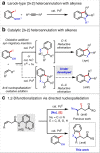Anti-selective [3+2] (Hetero)annulation of non-conjugated alkenes via directed nucleopalladation
- PMID: 33353940
- PMCID: PMC7755910
- DOI: 10.1038/s41467-020-20182-4
Anti-selective [3+2] (Hetero)annulation of non-conjugated alkenes via directed nucleopalladation
Abstract
2,3-Dihydrobenzofurans and indolines are common substructures in medicines and natural products. Herein, we describe a method that enables direct access to these core structures from non-conjugated alkenyl amides and ortho-iodoanilines/phenols. Under palladium(II) catalysis this [3 + 2] heteroannulation proceeds in an anti-selective fashion and tolerates a wide variety of functional groups. N-Acetyl, -tosyl, and -alkyl substituted ortho-iodoanilines, as well as free -NH2 variants, are all effective. Preliminary results with carbon-based coupling partners also demonstrate the viability of forming indane core structures using this approach. Experimental and computational studies on reactions with phenols support a mechanism involving turnover-limiting, endergonic directed oxypalladation, followed by intramolecular oxidative addition and reductive elimination.
Conflict of interest statement
The authors declare no competing interests.
Figures



Similar articles
-
Mapping Ambiphile Reactivity Trends in the Anti-(Hetero)annulation of Non-Conjugated Alkenes via PdII /PdIV Catalysis.Angew Chem Int Ed Engl. 2022 Mar 21;61(13):e202114346. doi: 10.1002/anie.202114346. Epub 2022 Feb 2. Angew Chem Int Ed Engl. 2022. PMID: 35007393 Free PMC article.
-
Palladium-catalyzed sequential oxidative cyclization/coupling of 2-alkynylphenols and alkenes: a direct entry into 3-alkenylbenzofurans.Org Lett. 2009 Mar 5;11(5):1083-6. doi: 10.1021/ol8028687. Org Lett. 2009. PMID: 19199489
-
Palladium-catalyzed Z-selective oxidative amination of ortho-substituted primary anilines with olefins under an open air atmosphere.J Org Chem. 2013 Jun 21;78(12):6332-7. doi: 10.1021/jo4010734. Epub 2013 Jun 12. J Org Chem. 2013. PMID: 23731281
-
Enantioselective Dicarbofunctionalization of Unactivated Alkenes by Palladium-Catalyzed Tandem Heck/Suzuki Coupling Reaction.Angew Chem Int Ed Engl. 2019 Oct 7;58(41):14653-14659. doi: 10.1002/anie.201907840. Epub 2019 Sep 5. Angew Chem Int Ed Engl. 2019. PMID: 31420928 Review.
-
Creation of Novel Toxic Gas Surrogates and the Development of Safe and Facile Catalytic Reactions.Chem Pharm Bull (Tokyo). 2018;66(1):1-19. doi: 10.1248/cpb.c17-00795. Chem Pharm Bull (Tokyo). 2018. PMID: 29311504 Review.
Cited by
-
Tunable [3+2] and [4+2] annulations for pyrrolidine and piperidine synthesis.Chem Commun (Camb). 2023 May 23;59(42):6418-6421. doi: 10.1039/d3cc01400b. Chem Commun (Camb). 2023. PMID: 37161704 Free PMC article.
-
Reverse Regioselective Dicarbofunctionalization via Anti-Michael-Type Addition.Angew Chem Int Ed Engl. 2025 Jun 17;64(25):e202505391. doi: 10.1002/anie.202505391. Epub 2025 Apr 21. Angew Chem Int Ed Engl. 2025. PMID: 40223540 Free PMC article.
-
Cytological mapping of a powdery mildew resistance locus PmRc1 based on wheat-Roegneria ciliaris structural rearrangement library.Theor Appl Genet. 2024 Nov 22;137(12):276. doi: 10.1007/s00122-024-04768-w. Theor Appl Genet. 2024. PMID: 39576288
-
Regio- and Stereoselective 1,2-Oxyhalogenation of Non-Conjugated Alkynes via Directed Nucleopalladation: Catalytic Access to Tetrasubstituted Alkenes.Angew Chem Int Ed Engl. 2022 Oct 24;61(43):e202209099. doi: 10.1002/anie.202209099. Epub 2022 Sep 29. Angew Chem Int Ed Engl. 2022. PMID: 36082442 Free PMC article.
-
Pd-Catalyzed Heteroannulation Using N-Arylureas as a Sterically Undemanding Ligand Platform.J Am Chem Soc. 2022 Apr 20;144(15):6667-6673. doi: 10.1021/jacs.2c01019. Epub 2022 Apr 5. J Am Chem Soc. 2022. PMID: 35380831 Free PMC article.
References
-
- Liu D, Zhao G, Xiang L. Diverse strategies for the synthesis of the indoline scaffold. Eur. J. Org. Chem. 2010;2010:3975–3984. doi: 10.1002/ejoc.201000323. - DOI
-
- Silva TS, et al. Recent advances in Indoline synthesis. Tetrahedron. 2019;75:2063–2097. doi: 10.1016/j.tet.2019.02.006. - DOI
-
- Bertolini F, Pineschi M. Recent progress in the synthesis of 2,3-dihydrobenzofurans. Org. Prep. Proc. Int. 2009;41:385–418. doi: 10.1080/00304940903240836. - DOI
-
- Larock RC, Yum EK. Synthesis of indoles via palladium-catalyzed heteroannulation of internal alkynes. J. Am. Chem. Soc. 1991;113:6689–6690. doi: 10.1021/ja00017a059. - DOI
Publication types
MeSH terms
Substances
Grants and funding
LinkOut - more resources
Full Text Sources

